Cats
7 Plants With 'Cat' in Their Name
Discover the mysterious plant with 'Cat' in its name that starts with 'L,' promising unique qualities that will pique your curiosity.

In the world of plants, seven species boast the intriguing name 'cat,' each offering distinct features that cater to both aesthetic and practical preferences. From Catnip's playful effects on feline friends to Cat Grass providing essential nutrients for them, these plants span a range of climates and benefits. Cat Thyme's Mediterranean charm and Catmint's pollinator-attracting blooms showcase nature's diversity. Cats Claw from the Amazon rainforest stands out for its medicinal uses, while Cats Tail adds a touch of whimsy with its dangling flowers. Cats Whiskers, with its medicinal qualities and ornamental appeal, round out this fascinating list. Uncover more about these captivating plants.
Key Takeaways
- Catnip: Triggers playful behavior in cats, used in teas, native to Asia and Europe.
- Cat Thyme: Fragrant leaves loved by cats, thrives in Mediterranean climates.
- Cats Claw: Amazon vine with medicinal properties, antioxidant and anti-inflammatory.
- Cats Tail: Tropical shrub with red or pink fuzzy tails, thrives in warm climates.
- Catmint: Aromatic foliage, drought-tolerant, attracts pollinators and supports local populations.
Catnip (Nepeta Cataria)
We find that Catnip (Nepeta Cataria) entices both humans and felines with its unique properties. This perennial herb, known for its irresistible attraction to our furry friends, contains nepetalactone, the compound responsible for triggering the playful behavior in cats.
On the human side, catnip can be brewed into calming teas, offering a soothing effect. Cultivating catnip is relatively easy, requiring warmth, humidity, and well-drained soil to thrive. It's a versatile plant native to Asia and Southern Europe, belonging to the mint family.
When grown in home gardens, catnip can be a delightful addition for both pets and their owners to enjoy. Whether watching cats revel in its euphoric response or sipping on a cup of catnip tea for relaxation, this herb's dual appeal makes it a valuable addition to any garden.
Cat Thyme (Teucrium Marum)
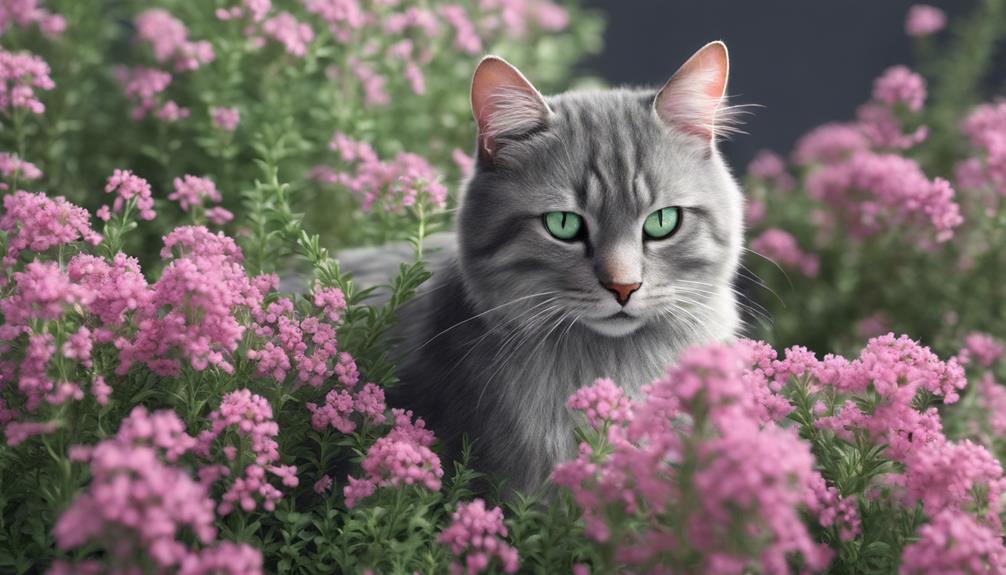
Cat Thyme, also known as Teucrium Marum, is a perennial herb loved by cats for its fragrant leaves. It thrives in Mediterranean climates and is a charming addition to rock gardens and herb gardens.
Discover the benefits of growing Cat Thyme and how to care for this aromatic plant in your own garden.
Cat Thyme Benefits
Discussing the benefits of Cat Thyme, also known as Teucrium Marum, reveals its potential medicinal properties and aromatic qualities. This herb, with its strong scent that attracts cats, isn't only a charming addition to gardens but also a source of herbal benefits.
Cat Thyme, native to the Mediterranean region, is known for being drought-tolerant and low-maintenance, thriving in well-drained soil. The small pink flowers it produces not only add a burst of color to garden beds and containers but also contribute to its aesthetic appeal.
Historically, Cat Thyme has been believed to possess medicinal properties, making it a valuable herb for both ornamental and potential therapeutic purposes.
Growing Cat Thyme
Cultivating Cat Thyme, a perennial herb from the mint family, demands attention to its specific soil and water needs to flourish in your garden.
Cat Thyme, also known as Teucrium Marum, is esteemed for its aromatic properties, resembling a blend of thyme and oregano. This low-growing shrub with gray-green leaves and clusters of pink to purple flowers is drought-tolerant and prospers in well-drained soil.
When tending to Cat Thyme, make sure it receives ample sunlight and avoid overwatering, as it prefers drier conditions.
Not only does Cat Thyme add a delightful fragrance to your garden, but it also attracts important pollinators like bees and butterflies, enhancing the biodiversity of your outdoor space.
Enjoy the benefits of this herb, similar to catnip, by nurturing it with care.
Cats Claw (Uncaria Tomentosa)
Cats Claw, scientifically known as Uncaria Tomentosa, is a vine native to the Amazon rainforest. This plant is widely utilized in herbal medicine due to its potential health benefits, such as antioxidant and anti-inflammatory properties.
For those interested in growing Cats Claw, understanding its benefits is important in cultivating this plant successfully.
Cats Claw Benefits
With its origins in the Amazon rainforest, Cat's Claw (Uncaria tomentosa) has garnered attention for its medicinal properties, particularly its immune-boosting and anti-inflammatory effects. This woody vine, known for its essential capabilities, has been used by indigenous tribes for generations.
Cat's Claw contains beneficial compounds such as alkaloids and polyphenols that contribute to its health benefits. Studies suggest that this plant may help reduce inflammation, support the immune system, and enhance overall well-being. Its popularity as a natural remedy continues to grow, with many turning to Cat's Claw for relief from conditions like arthritis, digestive issues, and viral infections.
Embracing the power of Cat's Claw could be a step towards enhancing our health and vitality.
Growing Cats Claw
Having originated in the Amazon rainforest, the tropical vine known as Cat's Claw (Uncaria tomentosa) has gained recognition for its potent medicinal properties.
Cats Claw, also called 'cat's claw' due to its curved thorns resembling a cat's claw, is a climbing vine native to the Amazon rainforest. This plant has been utilized in traditional medicine for centuries and is believed to possess immune-boosting and anti-inflammatory benefits.
When growing Cats Claw, it's important to provide support as it can climb up to 30 feet in height. By understanding the specific needs of this vine, such as proper support structures and adequate sunlight, one can cultivate a thriving Cats Claw plant that may offer various health benefits.
Cats Tail (Acalypha Hispida)
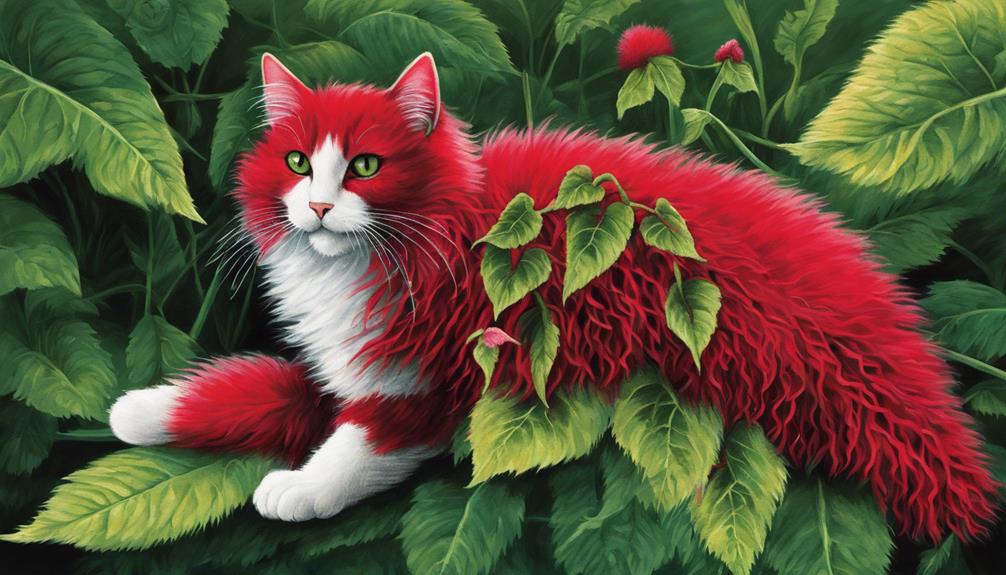
Referred to as the 'Chenille Plant' for its resemblance to a fuzzy caterpillar, the tropical shrub Cats Tail (Acalypha Hispida) boasts long, dangling red or pink fuzzy tails of flowers. This whimsical plant thrives in warm, humid climates, making it a perfect addition to gardens or as a decorative indoor plant. Its vibrant and unique appearance adds a playful touch to any space, creating a striking visual display with flowers that can grow up to 12 inches long. Here is a table to showcase the charming characteristics of the Cats Tail plant:
| Feature | Description |
|---|---|
| Appearance | Resembles a fuzzy caterpillar with long, red/pink tails |
| Ideal Climate | Thrives in warm, humid environments |
| Usage | Perfect for hanging baskets or indoor decoration |
Cats Tail (Acalypha Hispida) is not just a plant; it's a delightful companion that brings joy and color to any setting.
Catmint (Nepeta Faassenii)

Catmint (Nepeta Faassenii) pleasantly surprises gardeners with its aromatic foliage and charming lavender-blue flowers. This perennial herbaceous plant, a member of the mint family, is a favorite for many due to its low-maintenance nature and drought tolerance.
Not only does catmint add ornamental value to landscapes, but it also acts as a magnet for pollinators like bees and butterflies, enhancing the biodiversity of your garden. The delightful fragrance that emanates from its leaves makes it a crucial delight for anyone who encounters it.
Catmint isn't just visually appealing but also serves an essential role in supporting local pollinator populations, making it a valuable addition to any garden. Its ability to thrive in various growing conditions and resistance to deer further solidify its status as a must-have plant for both novice and experienced gardeners looking to create a vibrant and lively outdoor space.
Cat Grass (Dactylis Glomerata)

Cat Grass, also known as Dactylis Glomerata, is a cool-season perennial grass that's popularly cultivated as a special treat for feline companions. Felines are naturally drawn to this grass, which can be easily grown indoors or outdoors.
Besides being a delightful snack for cats, Cat Grass serves a beneficial purpose for their digestion. This grass provides a safe and natural source of fiber, aiding in digestion and promoting overall feline health. Packed with essential nutrients like folic acid, Cat Grass can contribute to enhancing the well-being of our beloved cats.
In addition, it offers a non-toxic alternative for cats to nibble on, reducing the risk of them consuming potentially harmful plants. By satisfying cats' instinctual urge to chew on grass, Cat Grass not only aids in their digestion but also provides mental stimulation, enriching their environment and promoting healthy behavior.
Cats Whiskers (Orthosiphon Stamineus)

Thriving in tropical climates, Cats Whiskers, scientifically known as Orthosiphon Stamineus, boasts elegant white or lavender flowers that add a touch of sophistication to any garden landscape.
This resilient plant, resistant to deer and rabbits, acts as a magnet for butterflies, enhancing the beauty of outdoor spaces with its ornamental allure. Cats Whiskers flourishes best under the warm embrace of part to full sun, requiring only average watering to thrive, making it a hassle-free addition to your garden.
Propagating this plant is a breeze, whether through seedheads or softwood cuttings, offering an effortless way to expand its presence in your outdoor sanctuary.
Beyond its aesthetic charm, Cats Whiskers also packs a punch with its medicinal benefits, aligning beauty with functionality seamlessly. Embrace the allure of Cats Whiskers in your garden, where its grace and utility intertwine to create a harmonious haven for both you and nature.
Frequently Asked Questions
What Is the Name of the Plant With a Cat in It?
Familiar with the plant with a cat in its name. It's Catnip, adored by cats and humans alike for its calming properties. Ideal for calming nerves or entertaining feline companions. The charm of Catnip!
What Is the Flower With the Word Cat in the Name?
We call it Catmint, also known as Nepeta. This flower, native to Asia and Southern Europe, grows up to 2-3 feet. Its leaves can flavor tea and trigger euphoria in some cats. It's a lovely addition to any garden.
What Flower Is Named After a Big Cat?
We found a stunning flower named after a big cat. Its vibrant orange blooms evoke the majestic leopard. This beauty, Iris domestica or Leopard Flower, captivates with its unique charm and ability to thrive in various light conditions.
What Is a Cute Flower Name for a Cat?
We think a cute flower name for a cat could be 'Kitty's Delight.' It attracts charm and elegance, enchanting butterflies and defying deer. It thrives in sunny spots with average watering needs, making it a delightful addition to any garden.
What Are Some Plants with ‘Cat’ in Their Name that Are Safe for Small Animals?
If you have small but strong animals, you may want to consider having catnip, catmint or cat thyme in your garden. These plants with “cat” in their name are safe for small animals and can provide a stimulating and enjoyable environment for them to explore.
Conclusion
To sum up, these plants with 'cat' in their name offer unique qualities and benefits for both indoor and outdoor gardening. While some may attract feline friends, others may provide medicinal properties or add aesthetic appeal to your garden.
By incorporating these plants into your landscape, you can create a harmonious environment that's both visually pleasing and beneficial for your well-being. Explore the world of 'cat' plants and discover the wonders they've to offer.
As our Editor-in-Chief, James plays a pivotal role in ensuring the quality and integrity of our content. With a keen eye for detail and a passion for storytelling, James oversees the editorial process here at A Place for Animals. With years of experience in content editing, James ensures that every piece of content meets our high standards of accuracy and clarity. Under James’ guidance, you can rest assured that the content you read is informative and impeccably crafted.
Cats
Top 10 Girl Cat Cartoon Characters Youll Love
Yearning for a feline fix? Uncover the enchanting world of the top 10 girl cat cartoon characters that will steal your heart!

As feline enthusiasts, we adore these top 10 girl cat cartoon characters! From Cleo's elegance to Duchess's sophistication, each whiskered wonder has a unique charm. Mimi brings mischief, Figaro offers playful antics, and Gumball dazzles with magic. Luna enchants with her musicality, Nermal's naivety warms hearts, and Snarf brings comedic relief. Catwoman's allure and Mittens' street-smart nature complete our purr-fect list. Discover the captivating world of these delightful feline personalities!
Key Takeaways
- Cleo: Epitome of elegance and grace.
- Duchess: Sophisticated Turkish Angora mother.
- Mimi: Spirited kitten promoting exploration.
- Luna: Mystical cat with musical enchantment.
- Catwoman: Iconic femme fatale with agile skills.
Cleo: The Elegant and Graceful Kitty
Cleo, the epitome of feline elegance, graces the animated world with her regal presence. Her sleek and shiny coat, paired with a posture that exudes sophistication, captivates audiences worldwide. We're drawn to Cleo's refined manners and graceful demeanor, making her a beloved character in various animated series. With a personality that's both poised and classy, Cleo sometimes displays a hint of aloofness, adding depth to her character.
As we watch Cleo navigate through her animated world, we can't help but admire her graceful and sophisticated nature. She stands out as a girl cat cartoon character that viewers adore, embodying a unique blend of charm and elegance. Cleo's character is a testament to the beauty and grace that can be found in animated feline personalities, leaving a lasting impression on those who appreciate her regal aura.
Duchess: The Sophisticated Aristocat
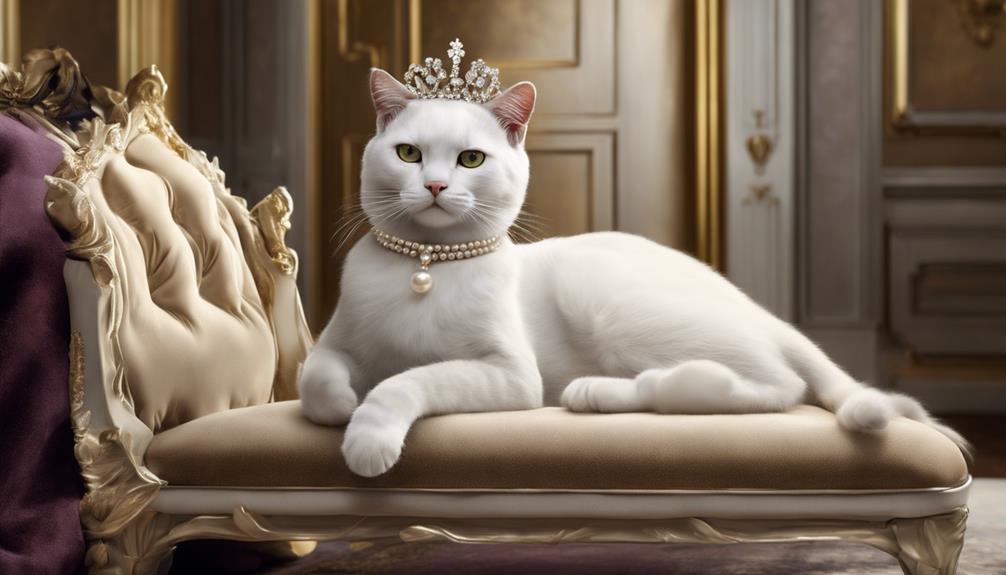
Duchess, the white Turkish Angora cat from Disney's The Aristocats, embodies sophistication and grace in her every movement. Voiced by Eva Gabor, Duchess is not just a cat; she's the epitome of elegance. As a mother to three adorable kittens – Marie, Berlioz, and Toulouse – her character exudes a refined demeanor that resonates with fans worldwide. Duchess's portrayal as a loving and protective mother adds depth to her already classy persona, making her a standout character in the realm of girl cat cartoons.
Let's take a closer look at what makes Duchess so special:
| Facts about Duchess | |
|---|---|
| Breed | Turkish Angora |
| Movie | The Aristocats |
| Voice Actor | Eva Gabor |
| Personality | Sophisticated |
Duchess's sophistication, coupled with her caring nature, creates a character that is both relatable and aspirational. Whether she's gracefully navigating the challenges of high society or showering her kittens with love, Duchess captivates audiences with her timeless charm.
Mimi: The Playful and Curious Kitten

Mimi is a lively kitten with a knack for mischief, always finding herself in playful predicaments that keep us entertained.
Her curiosity knows no bounds, leading her on exciting adventures that captivate viewers young and old.
With her endearing charm and spirited personality, Mimi is a beloved character who adds a delightful touch of fun to the show.
Mimis Mischievous Antics
Embarking on daring escapades and sparking laughter with her playful antics, the curious and mischievous kitten is a beloved character among fans of cat cartoons. Mimi's mischievous nature often lands her in hilarious situations that keep viewers entertained. Let's take a closer look at some of Mimi's most memorable antics in the table below:
| Mischievous Antic | Description |
|---|---|
| Chasing Butterflies | Mimi's playful side shines as she chases colorful butterflies around the garden. |
| Catapulting Tom | Reminiscent of the classic 'Tom and Jerry' antics, Mimi accidentally catapults Tom into a pile of pillows. |
| Feather Boa Fiasco | Mimi gets tangled in a feather boa, leading to a comical series of events as she tries to free herself. |
| Fishbowl Frenzy | In a quest for adventure, Mimi tips over a fishbowl, causing chaos as she tries to catch the fish. |
Mimis Curious Explorations
Exploring new territories with boundless curiosity and a playful demeanor, the adventurous kitten Mimi embarks on captivating journeys in 'Mimi's Curious Explorations.'
Mimi's cartoon character is designed to ignite the sense of wonder and adventure in young viewers. Through her inquisitive nature, Mimi encourages children to embrace curiosity, problem-solving, and learning valuable lessons.
The show featuring Mimi has captured the hearts of many young audiences, as they eagerly follow her exciting escapades. Mimi's adventures not only entertain but also promote important values like exploration and resilience.
Accompanied by her charm and wit, Mimi's character exemplifies the spirit of discovery and the joy of unraveling new experiences. In 'Mimi's Curious Explorations,' viewers are invited to join Mimi in her quest for knowledge and fun.
Mimis Playful Charm
With her playful charm and insatiable curiosity, this animated kitten captivates audiences of all ages in 'Mimi: The Playful and Curious Kitten.'
Mimi, from the world of girl cat cartoon characters, is a delightful bundle of energy that brings joy to viewers with her endearing personality. Her mischievous nature and adventurous spirit make her a beloved character in the hearts of many.
Whether she's embarking on exciting explorations or getting into playful antics, Mimi never fails to charm her way into the hearts of fans.
'Mimi: The Playful and Curious Kitten' beautifully showcases her playful charm, enchanting audiences with heartwarming moments and delightful adventures. Mimi's lovable demeanor and captivating presence make her a standout among girl cat cartoon characters, leaving a lasting impression on those who watch her in action.
Figaro: The Loyal Companion of Minnie Mouse
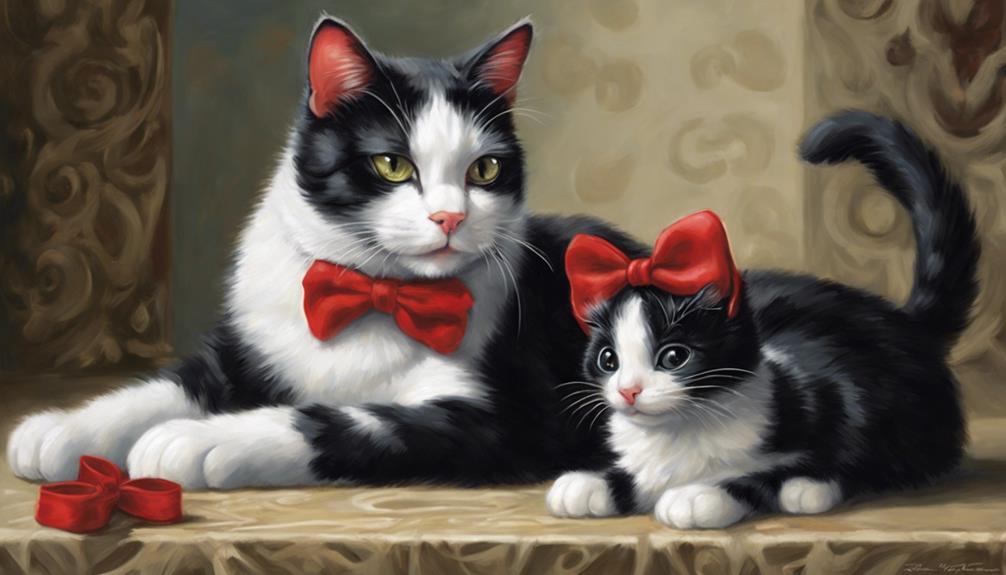
Figaro, the small tuxedo cat, has charmed audiences as the loyal companion of Minnie Mouse in various comic strips and animated shorts. Originally introduced in Disney's animated feature film 'Pinocchio' in 1940, Figaro quickly won hearts with his playful and mischievous nature. His endearing qualities shine through as he navigates humorous situations with Pinocchio and Cleo the goldfish.
Transitioning to his role as Minnie Mouse's devoted sidekick, Figaro's expressive facial expressions and adorable antics have solidified his status as a beloved character in Disney storytelling. Despite his diminutive size, Figaro boasts a big personality that resonates with viewers of all ages. The charm and timeless appeal he brings to the screen have made him a standout favorite among fans.
Figaro's journey from Pinocchio's mischievous companion to Minnie Mouse's loyal friend showcases his versatility and enduring popularity in the Disney universe.
Gumball: the Pink Cat With Magical Powers
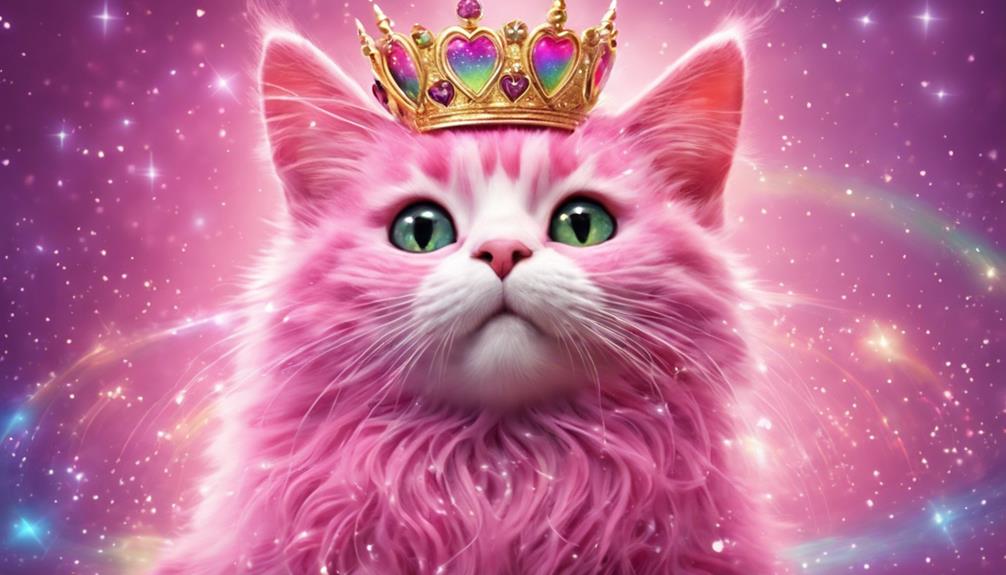
Gumball, the pink cat with magical powers, captivates audiences in the animated series 'The Amazing World of Gumball' with her mischievous antics and shape-shifting abilities. As a pink cat, Gumball brings a unique charm to the show, standing out with her vibrant color and playful demeanor. Her magical powers add an exciting twist to her character, allowing her to shape-shift into various forms and showcase extraordinary abilities.
Throughout the series, Gumball's adventures with her friends are filled with humor, creativity, and a touch of mischief, keeping viewers entertained and engaged.
Fans of 'The Amazing World of Gumball' appreciate the lovable and mischievous nature of this pink cat. Whether she's getting into hilarious predicaments or using her magical powers to navigate tricky situations, Gumball's personality shines through, making her a favorite among viewers. With her distinctive pink fur and entertaining escapades, Gumball is a character that leaves a lasting impression on those who tune in to watch her animated adventures.
Luna: The Musical and Mystical Cat
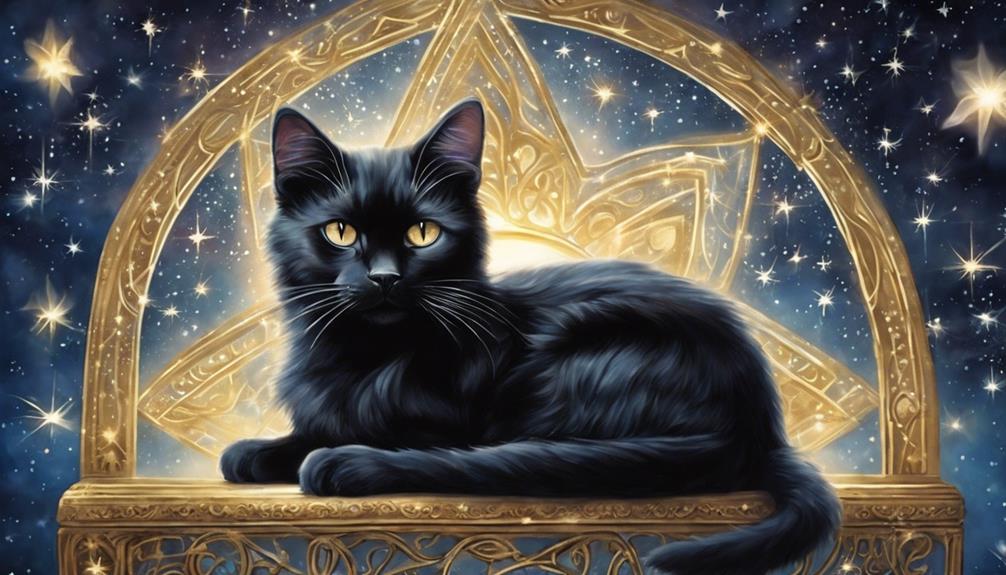
Luna, the musical and mystical cat from Sailor Moon, enchants audiences with her magical performances and enigmatic charisma. Her presence brings a touch of mystery and elegance to the series, captivating viewers with her psychic powers and unwavering loyalty to Sailor Moon.
Luna's crescent moon symbol on her forehead and telepathic communication with the Sailor Guardians add depth to her character, making her an integral part of the Sailor Scout team.
Lunas Magical Performances
In the whimsical world of 'Luna: The Musical and Mystical Cat,' enchanting performances unfold, captivating audiences with magical charm and musical prowess. Luna, with her feline friends, weaves a spellbinding tale through her mesmerizing musical abilities and captivating stage presence.
Fans are drawn to Luna's unique blend of music, magic, and undeniable feline charm, creating a dedicated following that adores her enchanting persona. Each performance in 'Luna: The Musical and Mystical Cat' is a delightful journey into a fantastical realm where dreams come alive, and hearts are touched by the sheer magic of it all.
Luna's magical performances not only entertain but also leave a lasting impression on those who witness her mystical talents in action.
Lunas Enigmatic Charisma
Amidst the whimsical world of 'Luna: The Musical and Mystical Cat,' radiates an enigmatic charisma that captivates all who encounter her presence.
Luna, the black cat with a crescent moon on her forehead from the anime series 'Sailor Moon,' exudes a mysterious and wise aura. Known for her guidance to the Sailor Guardians and her close bond with Usagi Tsukino, Luna symbolizes intuition, protection, and the Moon's connection.
In 'Sailor Moon: The Musical,' Luna's character shines as a magical and mystical feline companion, adding depth to the Sailor Guardians' journey. Her enigmatic charisma draws viewers into her world, where her wisdom and insights leave a lasting impact.
Luna's presence isn't just captivating but also essential to the magical essence of 'Sailor Moon.'
Nermal: The Adorable and Naive Kitten
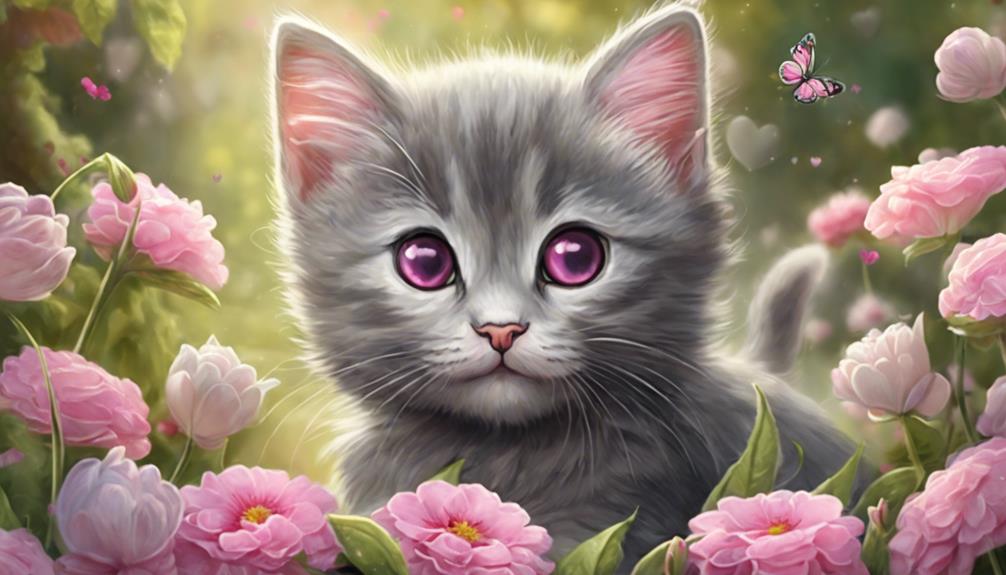
Nermal, the grey tabby kitten in the Garfield comic strip, captivates readers with his adorable and naive nature. Created by Jim Davis in 1979, Nermal is a lovable character known for his playful and innocent demeanor.
Despite being a minor character, Nermal's frequent appearances in the comic strip have endeared him to fans worldwide. His cute appearance and sweet personality make him a charming addition to the Garfield universe.
Interactions between Nermal and Garfield often highlight the contrast between Nermal's youthful exuberance and Garfield's more cynical outlook on life. Nermal's innocence and naivety add a touch of warmth and light-heartedness to the comic strip, making him a fan favorite.
Whether he's innocently getting under Garfield's skin or simply enjoying life, Nermal's presence brings a sense of joy and sweetness to the Garfield series that readers can't help but adore.
Snarf: the Furry Sidekick From Thundercats
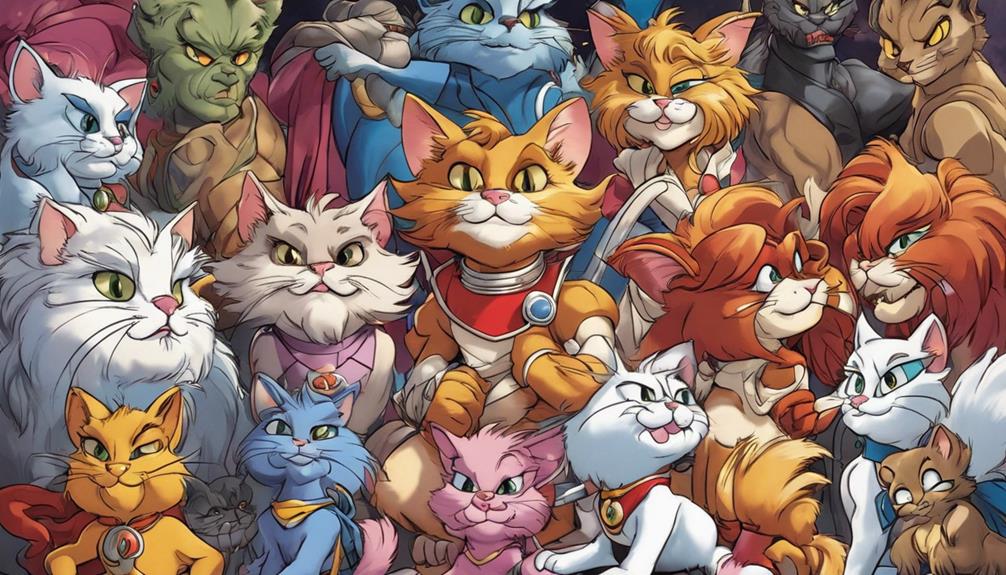
Snarf, the loyal and comedic sidekick from the animated TV series Thundercats, is known for his unwavering devotion to Lion-O, the leader of the Thundercats. This small, cat-like creature combines feline and human traits, adding a unique charm to the show. Despite not being the strongest Thundercat physically, Snarf plays a vital role in offering emotional support and wisdom to the team, making him an indispensable member of the group. His iconic catchphrase, 'Snarf, snarf!' has endeared him to fans, bringing a playful and memorable element to his character.
Here is a fun table to showcase some interesting facts about Snarf:
| Fact | Description |
|---|---|
| Role | Loyal sidekick to Lion-O, providing comedic relief and emotional support |
| Catchphrase | Iconic 'Snarf, snarf!' beloved by fans of the Thundercats series |
| Appearance | Small creature with a mix of feline and human features |
| Contribution to the team | Offers wisdom and support despite not being the physically strongest |
Catwoman: The Feline Femme Fatale

Catwoman is a captivating character known for her iconic costume, complex personality, and agile skills. Her sleek cat-themed outfit and whip are instantly recognizable, adding to her allure as a skilled burglar.
With a love-hate relationship with Batman, Catwoman's multifaceted nature keeps fans intrigued and coming back for more.
Catwomans Iconic Costume
With her sleek black bodysuit, cat-eared cowl, and signature whip, Catwoman's iconic costume exudes an aura of feline allure and danger. The combination of these elements creates a striking visual representation of her character, blending elegance with a hint of mystery.
The black bodysuit accentuates her agility and stealth, while the cat-eared cowl adds a playful yet fierce touch to her ensemble. Catwoman's whip serves not only as a weapon but also as a symbol of her independence and assertiveness.
Over the years, her costume has become synonymous with her persona, evolving to reflect different interpretations while maintaining the essence of her iconic look. Catwoman's attire truly embodies the essence of a femme fatale, captivating audiences with its alluring and formidable design.
Catwomans Complex Character
In exploring the depths of Catwoman's character, one uncovers a mesmerizing blend of cunning intelligence and feline grace. Catwoman, also known as Selina Kyle, is a complex anti-heroine in the DC Comics universe. She is a skilled thief with a strong moral code, often walking the line between good and bad. Below is a table that encapsulates the essence of Catwoman's character:
| Traits | Description |
|---|---|
| Intelligence | Sharp mind and strategic thinking |
| Morality | Complex moral compass, shades of gray |
| Agility | Swift and graceful movements |
| Affinity for Cats | Connection to feline companions and symbols |
| Relationship with Batman | Love, rivalry, and partnership dynamics |
Catwoman's character is multifaceted, making her a compelling and intriguing figure in the Batman universe.
Catwomans Agile Skills
Exploring the agile skills of this feline femme fatale reveals a mesmerizing display of speed and grace in action. Catwoman, also known as Selina Kyle, isn't only a skilled cat burglar and martial artist in the DC Comics universe but also a master of agility. Her movements are like a graceful dance, effortlessly navigating through obstacles and outmaneuvering her foes.
Catwoman's quick reflexes and acrobatic prowess make her a formidable opponent, capable of striking swiftly and vanishing into the shadows just as fast. Whether she's leaping across rooftops or executing precision heists, Catwoman's agility is a sight to behold, embodying the essence of a true cat-like predator in action.
Mittens: The Street-Smart and Resourceful Kitty
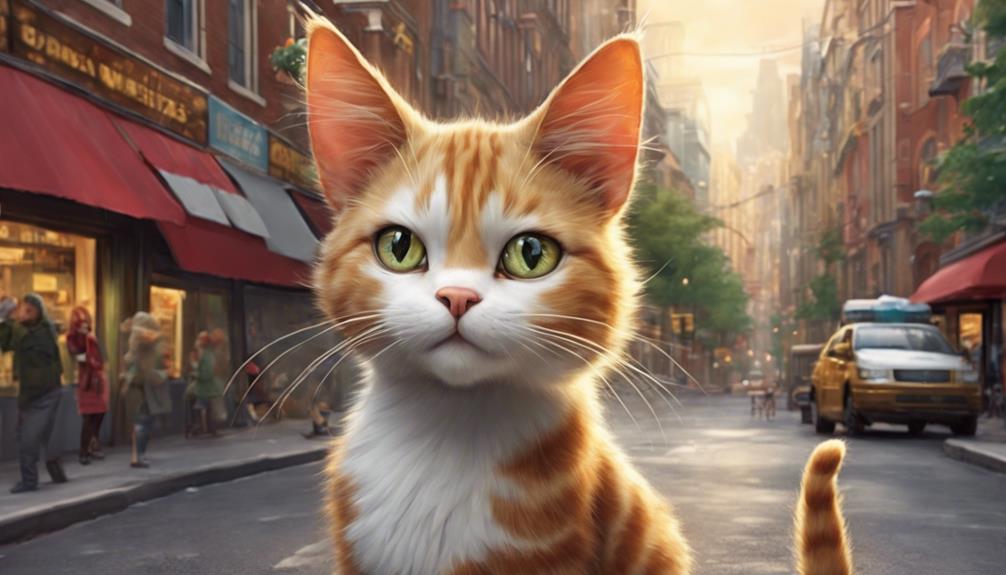
Navigating the bustling streets with cunning and quick thinking, Mittens proves to be a valuable ally to Bolt in the animated film 'Bolt'. Mittens, the street-smart and resourceful kitty, brings a unique charm to the story with her sassy attitude and unwavering loyalty. Here are a few reasons why Mittens captures our hearts:
- Survival Instincts: Mittens showcases her survival skills in every situation, teaching Bolt the ropes of the real world.
- Heartwarming Friendship: Her bond with Bolt goes beyond words, showing the audience the true meaning of friendship and support.
- Humorous Interactions: Mittens' witty remarks and banter with Bolt create delightful moments that keep viewers entertained.
- Character Growth: Throughout the film, Mittens undergoes significant development, adding depth to her persona and making her journey relatable.
Mittens' character brings a perfect blend of street-smart wisdom and warm-hearted companionship, making her an unforgettable feline heroine in the world of animated films.
Frequently Asked Questions
What Is the Most Popular Cartoon Cat?
When it comes to the title of the most popular cartoon cat, Garfield steals the spotlight. Created by Jim Davis in 1978, this lasagna-loving feline has won hearts worldwide with his iconic personality and humor.
Is There a Female Cartoon Cat?
Yes, there is a female cartoon cat. She embodies grace and mischief, capturing hearts with her charm. Cat characters like Duchess and Hello Kitty showcase the diversity and creativity found in animated storytelling, making them beloved icons.
Who Is the Most Famous Fictional Cat?
We think the most famous fictional cat is Garfield. He's known for loving lasagna and having a sarcastic attitude that makes him unforgettable. Garfield, created by Jim Davis in 1978, has captured the hearts of many.
What Cartoon Cat Is Like Hello Kitty?
When we think of a cartoon cat like Hello Kitty, we gravitate towards characters like Pusheen, who charms us with her adorable simplicity and relatable expressions. Pusheen captures hearts with her universal cuteness and appeal.
Conclusion
In conclusion, these top 10 girl cat cartoon characters are sure to capture your heart with their unique personalities and charm. Whether you're drawn to the elegance of Cleo or the playfulness of Mimi, there's a feline friend for everyone to love.
So next time you're looking for some entertainment, consider watching a show or movie featuring these beloved characters. You never know, you might just stumble upon your new favorite kitty companion!
Paul’s love for animals knows no bounds. As a dedicated writer and animal lover, Paul brings a unique perspective to our team. His firsthand experiences with various animals enrich our content and provide valuable insights into their behavior and needs. Whether he’s sharing tips for pet care or shedding light on pressing conservation issues, Paul’s passion for animals shines through in everything he does.
Cats
Are Burmese Cats Hypoallergenic?
Uncover the truth about whether Burmese cats are truly hypoallergenic, and find out why they might be a surprising choice for allergy sufferers.
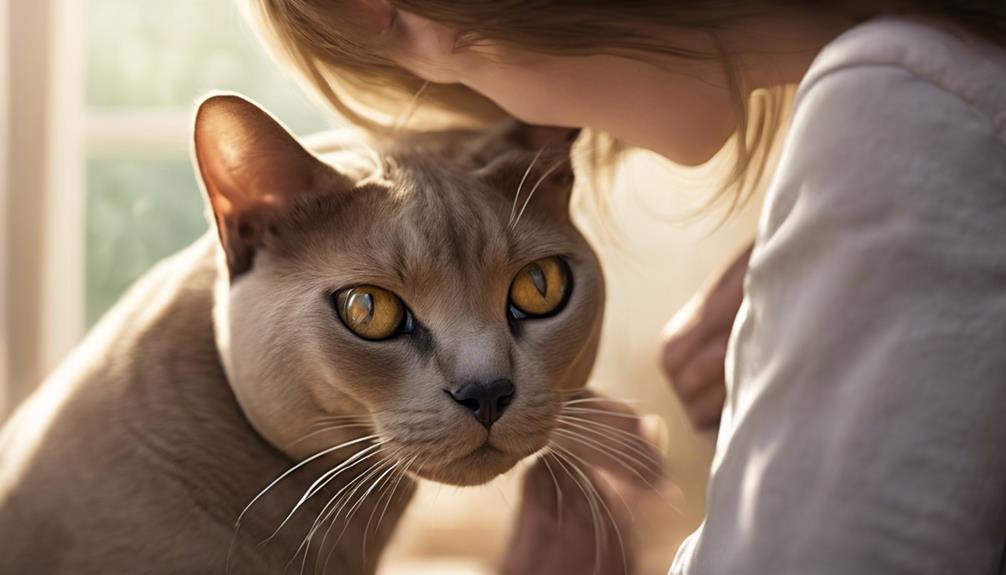
When it comes to allergies, Burmese cats are considered relatively hypoallergenic due to their low shedding and minimal dander. Their lower shedding levels make them a good choice for those with pet dander sensitivity. While they do release the Fel d1 protein in saliva, their overall allergen exposure rating is moderate. Regular grooming with a rubber curry brush is key to managing shedding and reducing allergen exposure. With proper care and cleaning routines, owning a Burmese cat can be a great option for those prone to allergies. Discover more about hypoallergenic Burmese cats to make an informed decision.
Key Takeaways
- Burmese cats have low shedding and minimal dander, making them hypoallergenic.
- Their grooming routine helps reduce allergen exposure significantly.
- Regular grooming practices are crucial for managing allergies.
- Burmese cats are rated 8/10 on the hypoallergenic scale.
- Keeping their living areas clean supports their hypoallergenic nature.
Burmese Cat Allergy Considerations
Considering the allergy implications of owning a Burmese cat is crucial for individuals sensitive to pet dander. While no cat breed is entirely hypoallergenic, Burmese cats are known for their lower shedding levels, which can make them a better choice for allergy sufferers.
It's essential to note that cat hair itself isn't the main culprit for allergies; instead, it's the protein Fel d 1 that causes reactions in sensitive individuals. To manage allergies effectively, cat owners can implement regular cleaning routines, establish cat-free zones in the home, and utilize HEPA air purifiers to reduce dander levels.
These measures can help minimize allergic reactions and create a more comfortable environment for both the cat and its owners. Consulting with an allergist can also provide valuable insights on living with a cat while managing allergies, helping individuals determine if a Burmese cat is a suitable option for their specific sensitivities.
Shedding Levels in Burmese Cats
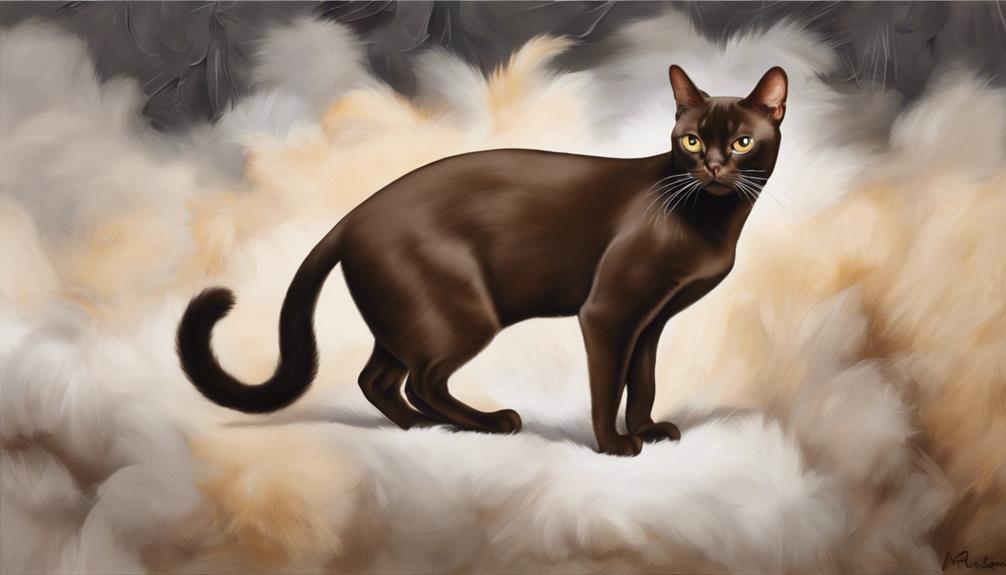
Burmese cats exhibit minimal shedding compared to many other breeds, with their shedding levels typically rated at 2/10. This low shedding is a key factor in their hypoallergenic nature, making them a great choice for individuals sensitive to allergens.
Monitoring your Burmese cat's shedding is essential, as any sudden increase could signal an underlying health concern that needs attention. Their fine, silky coat is relatively low maintenance, requiring only minimal grooming to keep it in top condition.
Regular brushing with a rubber curry brush not only helps manage shedding but also reduces allergen exposure, benefiting both you and your feline companion. By taking simple steps to care for your Burmese cat's coat, you can enjoy a cleaner home environment and fewer allergy triggers.
Burmese Cat Saliva and Dander

When assessing the allergen exposure potential of Burmese cats, their saliva and dander levels play crucial roles in determining sensitivity for individuals. Burmese cats are considered hypoallergenic due to their lower dander levels compared to many other breeds, which reduces allergen exposure. However, it's essential to note that they still release allergens, including the Fel d1 protein present in their saliva. The probability of saliva exposure from Burmese cats is rated at 4/10 for allergy concerns, while their dander levels are rated at 3/10, indicating a lower risk for allergy sufferers.
| Aspect | Rating |
|---|---|
| Saliva Exposure | 4/10 |
| Dander Levels | 3/10 |
| Allergen Exposure | Moderate |
| Fel d1 Presence | Yes |
| Allergy Concerns | Considerable |
Regular grooming practices can significantly help manage dander levels and reduce the potential for allergic reactions in sensitive individuals. By staying on top of grooming routines, you can create a more comfortable environment for both you and your Burmese cat.
Grooming Tips for Allergy Management
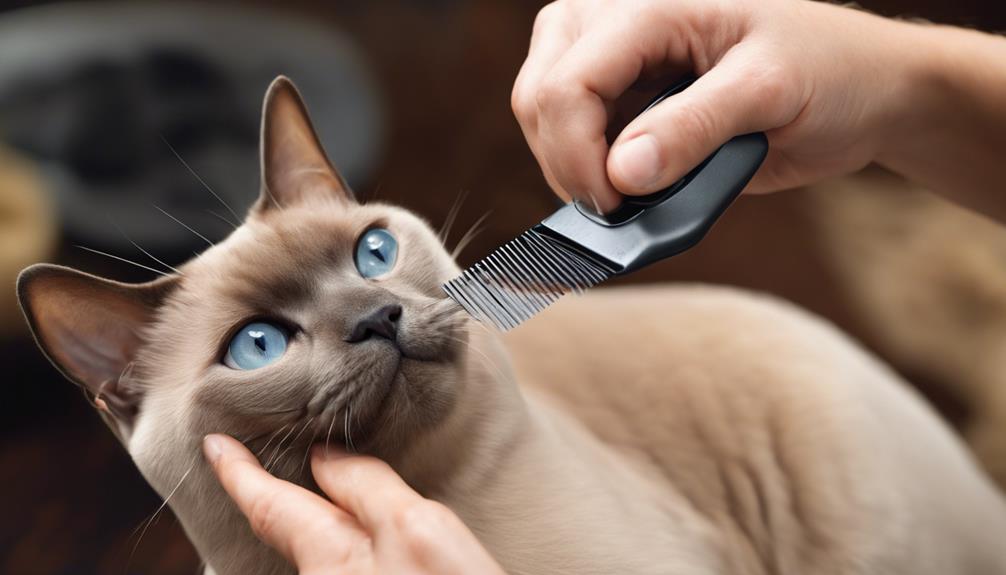
To effectively manage allergies, incorporating regular grooming practices into our routine is essential for keeping allergen levels low on our Burmese cat. Burmese cats are good for allergy management due to their low shedding and less dander production. By committing to weekly brushing sessions, we can help reduce allergens on our feline friend, making it easier for allergic individuals to coexist with them.
As responsible cat parents, it's crucial to understand that proper grooming not only benefits our Burmese cat but also contributes to managing allergies in our homes. The ease of grooming Burmese cats makes it a practical choice for those seeking hypoallergenic cat breeds. Additionally, the self-grooming habits of Burmese cats play a role in maintaining a clean coat and minimizing the spread of allergens in our living spaces.
Hypoallergenic Burmese Cat Care
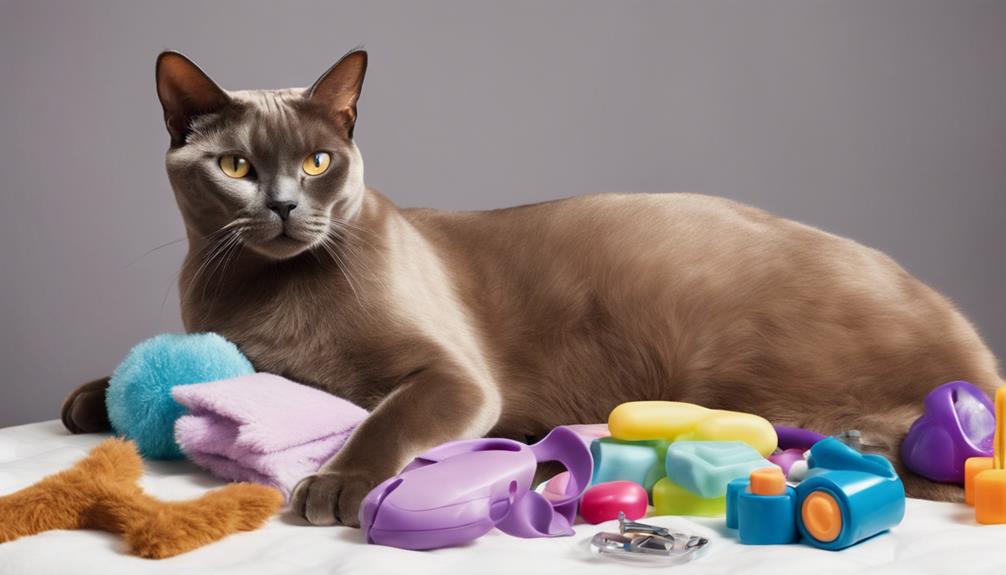
Maintaining a grooming routine is crucial for effectively caring for a hypoallergenic Burmese cat. Due to their low shedding and minimal dander production, Burmese cats are considered suitable for individuals with mild to moderate allergies. These feline friends produce lower amounts of allergenic proteins like Fel d1, earning them an 8/10 hypoallergenic score.
Regular grooming practices play a vital role in managing shedding and reducing allergen exposure in Burmese cats. While no cat breed is entirely hypoallergenic, Burmese cats are a great choice for allergy sufferers because of their low allergen production.
To ensure your hypoallergenic Burmese cat stays comfortable and allergy-friendly, make grooming a part of your routine. Brush their coat regularly to minimize shedding and dander. Bathing can also help reduce allergens on their fur. Additionally, keeping their living area clean and free of dust and allergens can further support their well-being.
Frequently Asked Questions
Are Burmese Cats Bad for Allergies?
For allergies, Burmese cats are a good choice. They shed less and produce less dander, reducing allergy risks. While not allergen-free, proper grooming can manage allergens. Living with a Burmese cat is usually comfortable for allergy sufferers.
What Is the Most Hypoallergenic Cat?
When looking for the most hypoallergenic cat, we consider breeds like the Sphynx, Cornish Rex, and Devon Rex due to their low shedding and dander production. Balinese cats are also known for being a great choice for allergy sufferers.
Are Burmese Cats Cuddly?
Oh, absolutely! Burmese cats are incredibly cuddly. They love being close to us, seeking attention and affection. Their affectionate nature and desire for physical contact make them wonderful companions who enjoy snuggling and being held.
Are Burmese Cats Low Maintenance?
We find caring for Burmese cats a breeze. Their short coat requires minimal effort, rating their grooming needs at 3/10. Regular brushing keeps shedding in check. They're self-groomers, reducing the need for baths.
Conclusion
In conclusion, while Burmese cats aren't completely hypoallergenic, their low shedding levels and manageable grooming needs make them a suitable option for some allergy sufferers.
By regularly grooming your Burmese cat and keeping your living space clean, you can help reduce allergens and enjoy the companionship of these affectionate felines.
So, if you're considering adding a Burmese cat to your family but have allergies, don't let that stop you from experiencing their playful and loving nature.
Paul’s love for animals knows no bounds. As a dedicated writer and animal lover, Paul brings a unique perspective to our team. His firsthand experiences with various animals enrich our content and provide valuable insights into their behavior and needs. Whether he’s sharing tips for pet care or shedding light on pressing conservation issues, Paul’s passion for animals shines through in everything he does.
Cats
Can Cats Eat Ham?
Satisfy your curiosity about whether cats can eat ham and discover important considerations for their health and well-being.

Cats can eat ham as an occasional treat. Ham offers protein, vitamins, and minerals beneficial for cats. However, high sodium in ham can cause dehydration and kidney problems in cats. Taurine in ham is important for vision and heart health, but too much can upset digestion. Monitoring sodium intake and selecting low-salt options is vital. Finding a balance between ham and a regular diet helps maintain hydration. For kittens, introduce ham slowly due to sensitive stomachs. Choose homemade, unseasoned ham in small portions to avoid digestive issues. Consider the quality of ham to prioritize feline health subtly suggest more information ahead.
Key Takeaways
- Cats can eat ham in moderation for protein, but high sodium levels can harm their health.
- Taurine in ham supports cats' vision and heart function.
- Monitor sodium intake and digestive reactions when feeding ham to cats.
- Limit ham as occasional treats to prevent obesity and digestive issues.
- Opt for high-quality, unseasoned ham to ensure feline well-being.
Ham Nutritional Value for Cats
Taking into account the nutritional benefits of ham for cats, it's vital to comprehend its role in providing essential nutrients like protein and vitamins. Cats thrive on a diet rich in protein, and ham offers a lean source that supports muscle growth and overall health.
The amino acids, vitamins such as B6, and minerals like selenium and zinc found in ham are all advantageous for our feline friends. Taurine, a critical component present in ham, aids in maintaining normal vision, digestion, and heart function in cats.
With cats requiring a daily intake of at least 2 grams of protein per pound of body weight, incorporating ham in moderation can help meet this dietary need. However, due to its high-fat content, ham should be given sparingly to prevent weight gain and ensure a well-balanced diet for cats.
When selecting cat food containing ham, it's important to assess the overall nutritional profile and monitor portion sizes to keep our furry companions healthy and happy.
Sodium Concerns With Cats Diet
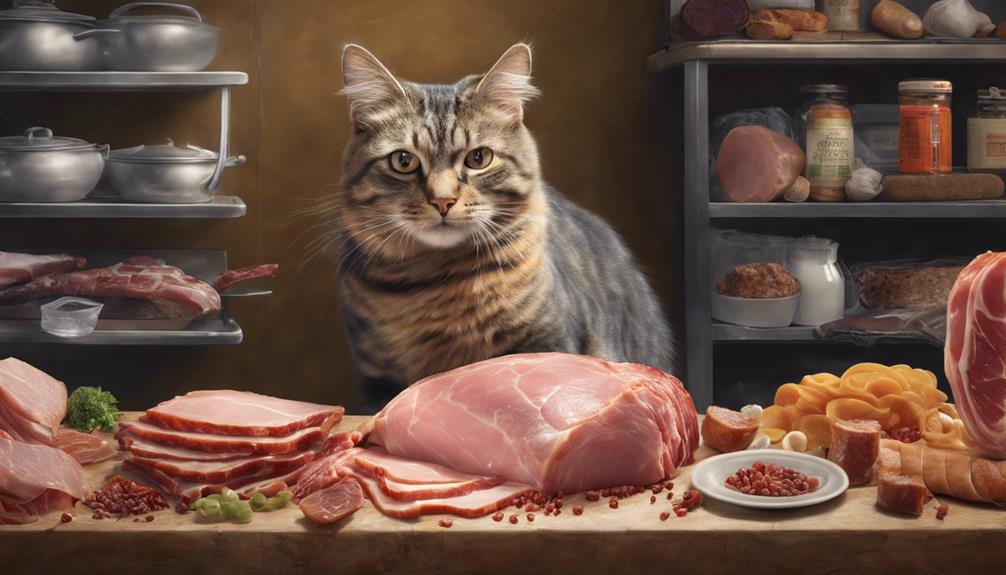
After discussing the nutritional benefits of ham for cats, it's important to address the potential risks associated with high sodium content in their diet. Cats have a low tolerance for sodium, making the much salt present in ham a concern for their health. Excessive sodium intake can lead to dehydration and kidney issues in cats.
Their bodies aren't well-equipped to handle the high levels of salt found in ham, which can have negative effects on their well-being. Monitoring sodium intake is essential to maintaining a cat's overall health. Limiting salty foods like ham can help prevent potential health problems in cats, ensuring they stay happy and healthy for years to come.
When considering what cats eat, it's crucial to prioritize their pet health and make informed choices that support their well-being. By being mindful of the sodium content in their diet, we can help our feline friends live their best lives.
Protein Needs for Feline Health
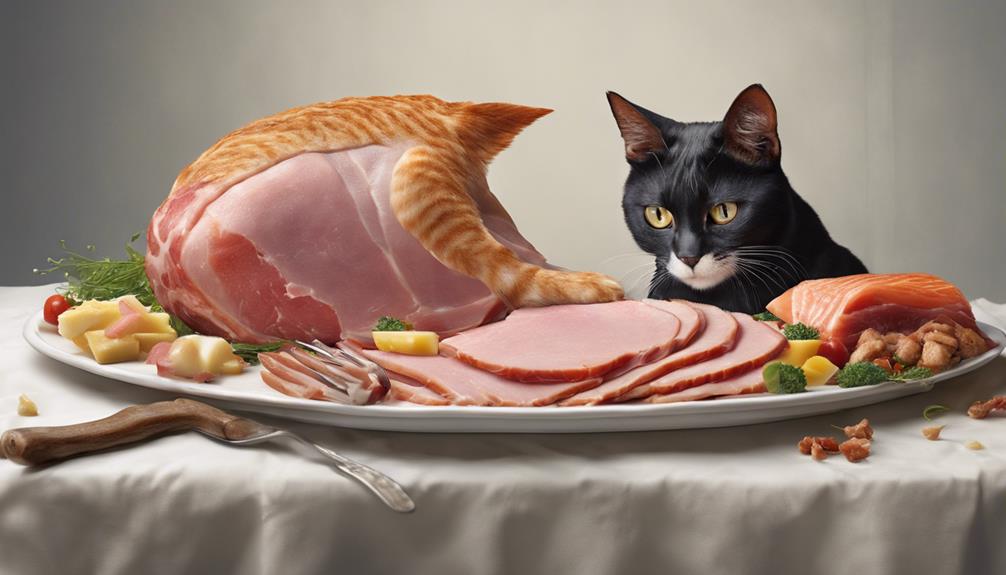
To guarantee peak health and well-being in cats, prioritizing their protein needs is essential. Cats, as obligate carnivores, require animal protein like that found in ham for the best muscle development and overall health.
Taurine, an essential amino acid present in protein-rich foods such as ham, plays a critical role in maintaining normal functions in cats. Ensuring that our feline friends receive adequate protein intake, like that from ham, supports vital areas like vision, digestion, and heart health.
Balancing a cat's diet with protein-rich sources such as ham is fundamental in meeting their nutritional requirements and promoting a robust and healthy life. Remember, providing a balanced diet that includes sufficient protein is key to keeping our beloved cats thriving and happy.
Ham as a Medication Concealer
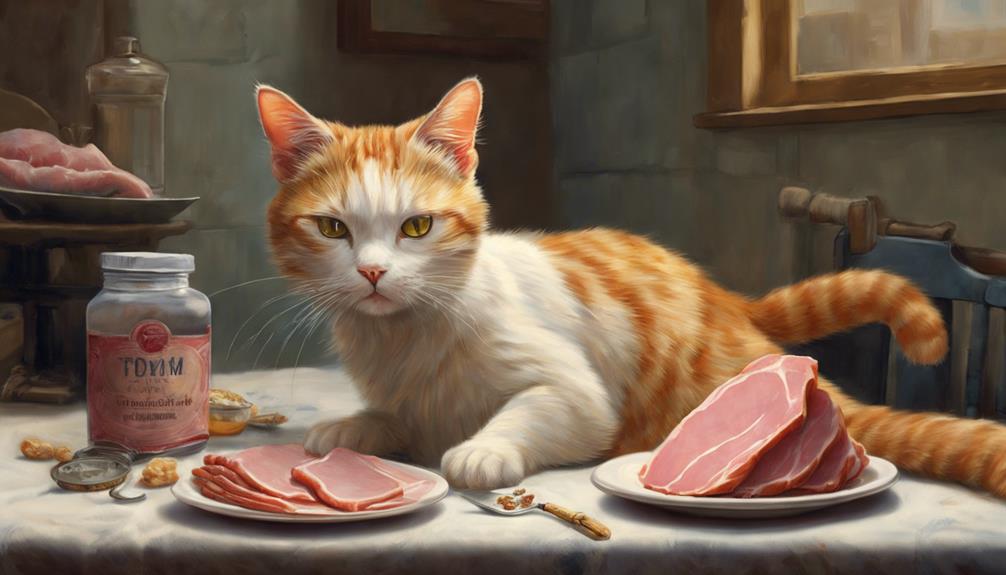
When it comes to giving medication to our feline friends, ham can be a lifesaver. Wrapping pills in a small piece of ham can make the process smoother for both cats and owners.
The strong scent and taste of ham can help mask the medication's flavor, ensuring our cats get the treatment they need without a fuss.
Ham Hides Pills
Using ham as a medication concealer for cats can be a clever way to make sure they take their pills without resistance. Cats may not always be cooperative when it comes to medication, but wrapping a small piece of ham around the pill can make it more enticing.
The strong aroma and flavor of ham can effectively mask the taste of the medication, making it easier for cats to consume. This trick can be especially handy for cat owners dealing with stubborn felines who refuse to take their pills.
Just remember to use a small amount of ham to avoid overfeeding and maintain your cat's balanced diet. With this method, giving your cat medication can become a smoother and less stressful experience for both of you.
Medication Disguised in Ham
We find ham to be a clever disguise for administering medication to cats. When it comes to hiding medication in ham, it can make the process of giving your feline friend their necessary treatment much essential. Cats tend to be more cooperative when their medication is concealed within a tasty piece of ham, making it easier for pet owners to administer the needed meds.
Ensuring that the medication is securely hidden within the ham is vital to guarantee that the correct dosage is consumed. Monitoring your cat after administering the medication-disguised ham is necessary to confirm ingestion and prevent any potential adverse reactions. With the help of ham, giving medication to your cat can be a stress-free experience for both you and your furry companion.
Concealing Meds With Ham
Concealing medication in ham serves as a clever solution for pet owners dealing with cats reluctant to take pills or liquid medication. The strong smell and taste of ham can help mask the flavor of medications, making it easier for your feline friend to swallow.
Here's why using ham as a medication concealer is advantageous:
- Ham can conceal the medication effectively.
- It can make giving medication less stressful for both the cat and the owner.
- Wrapping a small pill or mixing liquid medication with ham can guarantee your cat consumes the medication without resistance.
Impact of Ham on Cats Digestion
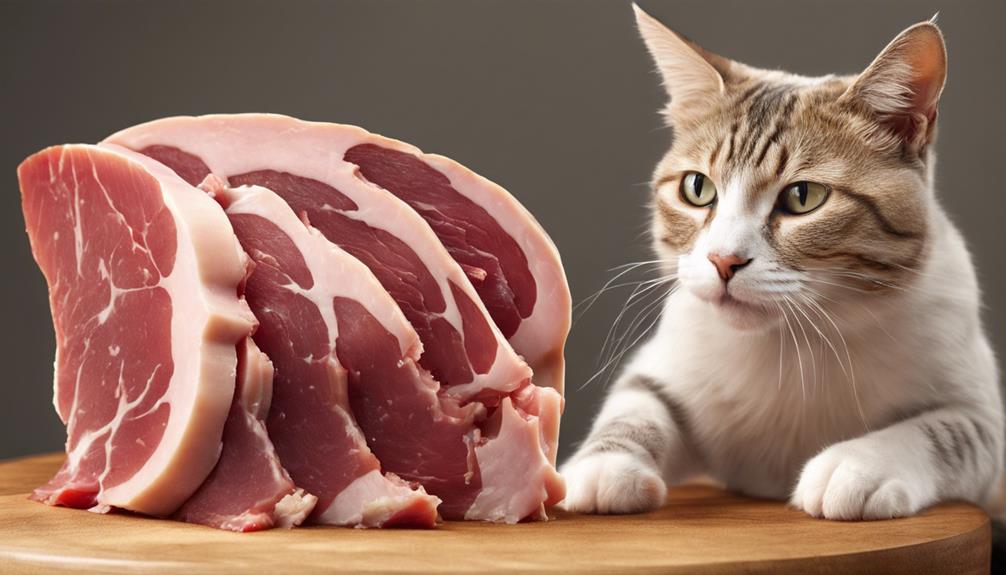
Ham's high sodium content can have a significant impact on a cat's digestion, potentially leading to stomach upset. Cats have sensitive stomachs, and consuming too much ham, with its elevated salt levels, can cause digestive issues. Even small amounts of ham can be challenging for cats to digest due to their unique dietary requirements.
Seasonings or additives in ham can exacerbate these problems, further upsetting their stomachs. Monitoring your cat for any signs of discomfort or adverse reactions after feeding them ham is crucial. To prevent nutritional imbalances and digestive disturbances, opting to limit the amount of ham your cat consumes is advisable.
Choosing high-quality cat food that meets their nutritional needs is a safer choice. By being mindful of how much ham you offer your feline friend and observing their digestive well-being, you can help maintain their overall health and happiness.
Taurine and Minerals in Ham
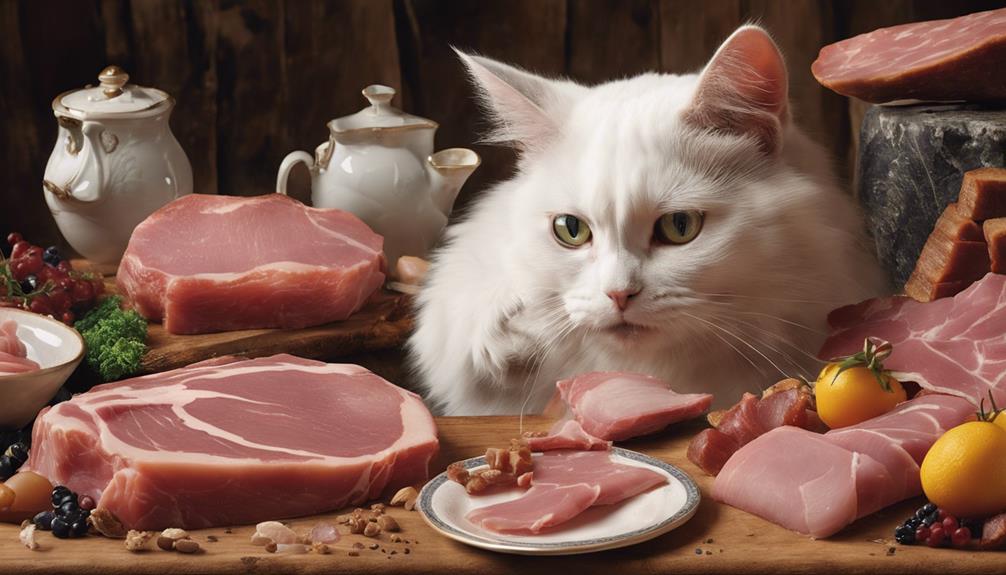
Incorporating ham into a cat's diet in moderation provides essential taurine for normal functions and important minerals like zinc, selenium, and potassium important for overall health. When it comes to taurine and minerals in ham for cats, here are some key points to take into account:
- Taurine Support: Ham contains essential taurine that aids in various functions in cats, including vision, digestion, and heart health.
- Overall Well-being: Taurine found in ham plays a significant role in the development of healthy tissues, contributing to a cat's overall well-being.
- Mineral Rich: Ham is a good source of minerals such as zinc, selenium, and potassium, which are essential for maintaining a cat's health.
Cats rely on adequate taurine intake from sources like ham to prevent nutritional deficiencies and related health issues. By including ham in their diet in moderation, you can help make sure your feline friend receives the necessary minerals and nutrients for excellent health.
Moderation in Ham Treats for Cats

To maintain a cat's health, it's important to regulate the frequency and portion sizes of ham treats given. While cats may enjoy the occasional taste of ham, it's vital to remember that moderation is key. Limiting these treats to 2-3 times a week in small portions can help prevent potential health risks associated with excessive salt intake. Cutting ham treats into smaller bites is also essential to avoid any choking hazards for our feline friends.
Ham for Hydration Balance in Cats

When thinking about ham as a special reward for cats, it's important to be mindful of its high salt content and potential impact on hydration levels.
Cats naturally have a low thirst drive, so it's vital to monitor their water intake when offering ham. Providing fresh water alongside ham treats can help maintain a healthy hydration balance for our feline friends.
Ham as Treat
Considering a cat's hydration needs, providing ham as a treat can be a practical way to entice them to drink more water. Cats may find the flavor and texture of ham appealing, making it a useful tool for hydration encouragement.
Balancing ham treats with a cat's regular diet can help maintain their overall hydration levels and guarantee they're receiving enough fluids. It's important to monitor your cat's reaction to ham treats, especially when offering them in small amounts, to see if they benefit from the additional hydration.
Water Content in Ham
Shifting to the discussion of water content in ham for hydration balance in cats, we find that ham's relatively low moisture content may not significantly contribute to a cat's overall hydration needs. While ham can be a tasty treat for your feline friend, it's important to remember that cats rely more on water intake from their regular diet and drinking water to stay properly hydrated.
Offering fresh water at all times is essential for maintaining their hydration levels. Cats may not obtain sufficient hydration from ham alone, emphasizing the importance of providing access to clean water. Monitoring your cat's water intake is key for their health and well-being, regardless of their enjoyment of ham.
Fat Intake Caution With Ham
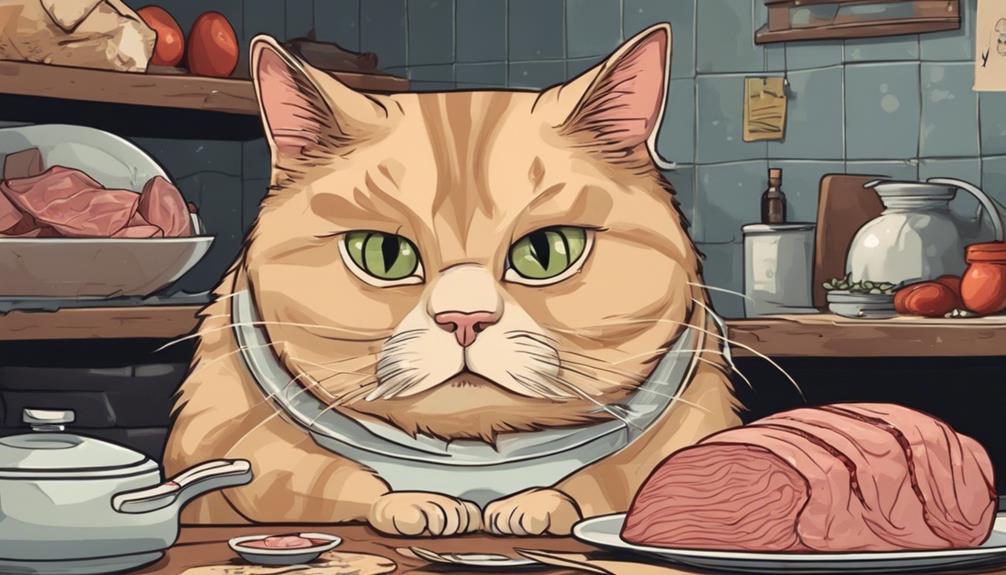
Limiting the intake of ham due to its high fat content is important to safeguarding the health of cats. When it comes to feeding your feline friend, keeping an eye on fat intake from ham is vital. Here are some key points to keep in mind:
- Excessive fat from ham can lead to obesity and other health issues in cats.
- High-fat foods like ham can strain a cat's digestive system, potentially causing pancreatitis.
- Cats have a limited ability to process fats efficiently, making it important to monitor their fat intake carefully.
Delicate Digestive Systems of Kittens

Kittens, being young and still developing, have delicate digestive systems that need special attention.
When it comes to introducing new foods like ham, it's imperative to take into account their sensitivity and potential digestive issues.
Ensuring a balanced diet tailored to kittens' nutritional needs is essential for their healthy growth and well-being.
Kitten Digestive Sensitivity
Exploring the delicate digestive systems of kittens requires careful consideration of their specific nutritional needs and potential sensitivities to certain ingredients. When it comes to what kittens eat, feeding your cat deli meat like ham can pose risks due to their sensitive stomachs. To guarantee your kitten's well-being, it's essential to be mindful of their digestive sensitivity.
- Kittens have delicate digestive systems that can be easily upset by new or inappropriate foods.
- Their digestive systems are still developing and may not be able to handle certain ingredients found in ham.
- Introducing new foods, like ham, to kittens should be done cautiously to avoid digestive issues.
Seeking advice from a veterinarian before making any dietary changes is advisable to support their growth and health.
Dietary Considerations for Kittens
Understanding the dietary needs of kittens is essential due to their delicate digestive systems that require specialized nutrition for peak growth and development. Kittens have sensitive stomachs that may not tolerate high-fat or heavily seasoned foods like ham. Special diets tailored to kittens are vital in ensuring they receive the right nutrients without causing digestive issues.
When introducing new foods, such as ham, it's important to do so gradually to monitor any adverse reactions. Certain ingredients in ham may be challenging for kittens to digest, potentially leading to digestive issues. Consulting a vet before incorporating ham or any new food into a kitten's diet is necessary to safeguard their health and well-being.
Prioritizing their dietary considerations will help kittens thrive and grow into healthy adult cats.
Feeding Guidelines for Ham to Cats
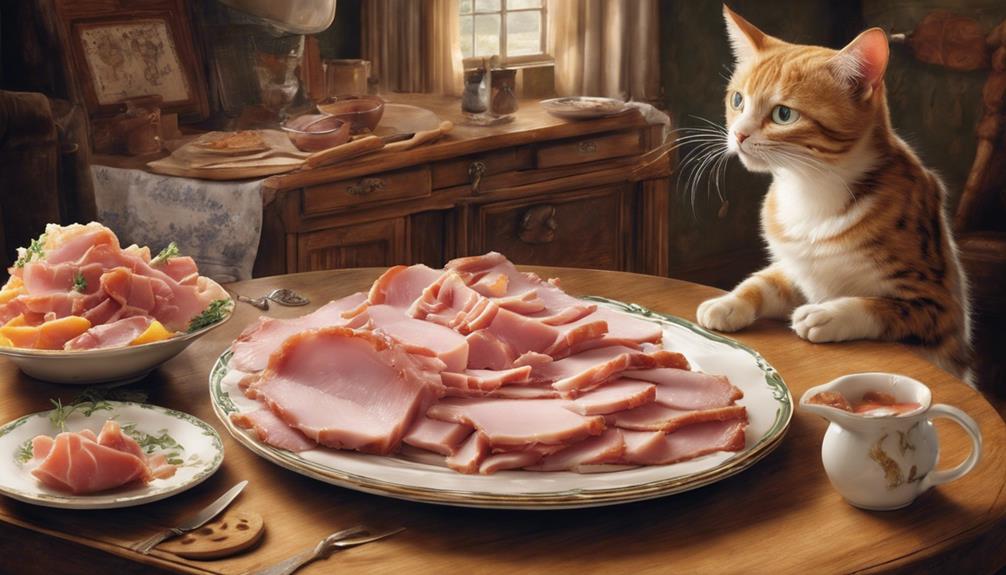
When providing ham to cats, it's important to limit the serving size to a 1-inch cube, 2-3 times a week to prevent nutritional imbalances. Cats enjoy the taste of ham, but moderation is crucial to keeping them healthy and happy. To guarantee your feline friend benefits from this treat, consider the following guidelines:
- Cut Into Small Pieces: Chopping ham into smaller bites can help prevent choking hazards and make it easier for your cat to enjoy.
- Stick to Homemade, Unseasoned Options: Opting for homemade ham without seasonings or additives is the safest choice for your cat's delicate digestive system.
- Treat, Not Staple: Bear in mind that ham should be viewed as an occasional indulgence rather than a regular part of your cat's diet.
High-Quality Ham Selection Tips

When selecting top-notch ham for your cat, go for low-salt, fully cooked options to minimize their sodium intake.
Homemade cooked ham is a superior option over deli meats that contain preservatives and spices.
Fresh ham cooked at home guarantees that no harmful chemicals are present in the meat, keeping your feline friend safe and healthy.
Ham Quality Factors
In selecting ham for cats, prioritize choosing low-salt, high-quality options to minimize their sodium intake. When considering ham quality factors, keep these tips in mind:
- Opt for homemade cooked ham over processed deli meat to avoid additives.
- Guarantee the ham is thoroughly cooked to eliminate any harmful bacteria.
- Avoid seasoned or flavored ham to prevent potential digestive issues in cats.
Choosing the Best
For best health benefits, prioritize selecting low-salt, high-quality ham options when choosing a suitable treat for your feline companion. Opting for ham with minimal seasoning and preservatives guarantees your cat's safety and well-being.
Homemade cooked ham, free from harmful additives, is a superior choice than deli meat. Raw ham cooked at home can provide essential vitamins and minerals without the risk of unwanted chemicals.
When considering ham as a special treat for your cat, always check the ingredients to avoid potential digestive issues. By being mindful of the quality of ham you offer your feline friend, you can provide a delicious and nutritious snack that they'll enjoy while keeping them healthy and happy.
Small Portion Recommendations for Cats
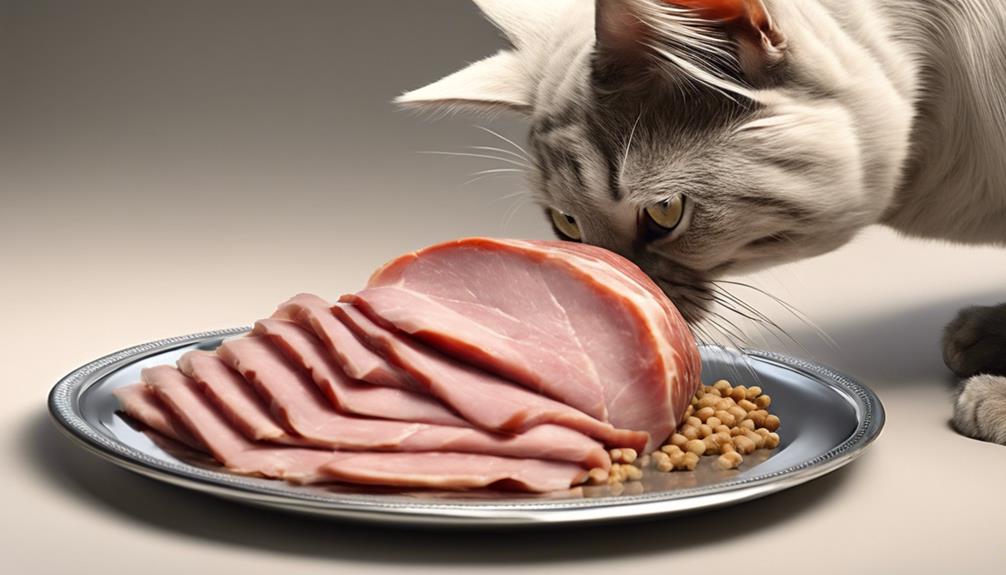
To guarantee safe consumption, cats should be given ham in small, bite-sized portions. When it comes to feeding your cat ham, it's crucial to keep portions in check to ensure their well-being. Here are some key points to keep in mind:
- Limit servings: Stick to a 1-inch cube serving of ham for your feline friend, offering it 2-3 times a week.
- Prevent choking hazards: Cutting the ham into smaller bites can help reduce the risk of choking, making it easier for your cat to enjoy their treat.
- Treat, not a staple: Remember that ham should be considered a special treat and not a regular part of your cat's diet.
Foods to Avoid Beyond Ham

Beyond ham, it's important to steer clear of certain foods that can be toxic or harmful to cats. Since cats are carnivores, their digestive systems are not equipped to handle certain human foods. Foods like raw meats can pose risks of salmonella and E. coli infections in cats, making it vital to avoid them. Additionally, garlic or onion, commonly used ingredients in many dishes, are toxic to cats and should never be included in their diet. To help you understand better, here is a table highlighting some foods that are harmful to cats:
| Toxic Foods | Harmful Effects |
|---|---|
| Chocolate | Toxic to cats |
| Onions | Can cause blood-related issues |
| Grapes | Can lead to kidney failure |
It's crucial to keep these foods away from your feline friend to guarantee their health and well-being. If your cat accidentally ingests any of these unsafe foods, don't hesitate to contact a vet immediately for guidance and assistance.
Safe Food Options for Feline Diet

Exploring nutritious options for a feline diet is essential for maintaining a cat's overall health and well-being. When considering what to feed your furry friend, it's important to provide a balanced and wholesome diet.
Here are some safe food options that can benefit your cat's health:
- Lean Protein Sources: Opt for lean meats like chicken or turkey, ensuring they're cooked thoroughly and free from seasonings that may be harmful to cats. These proteins are essential for muscle growth and overall health.
- Fish: Fish such as salmon or tuna can be a great source of omega-3 fatty acids, which help support your cat's coat and skin health.
- Fruits and Vegetables: While cats are obligate carnivores, small amounts of fruits like blueberries or vegetables like steamed carrots can provide additional vitamins and fiber to their diet.
Frequently Asked Questions
Is Ham Toxic to Cats?
Ham is not toxic to us cats, but moderation is key due to its high sodium content. We can enjoy plain, cooked ham as a treat, but it shouldn't replace our balanced diet to avoid health issues.
Can Cats Eat Eggs and Ham?
We love treating our feline friends to eggs occasionally. They provide proteins and vitamins for their health. As for ham, it's a different story. Ham is high in salt and fat, not ideal for cats.
Can Cats Eat Honey Baked Ham?
We enjoy treating our feline friends to honey-baked ham in moderation. It's important to offer plain pieces without added sugars to prevent health issues. Remember, a few bites a day are plenty to keep our cats happy and healthy.
What Meats Can Cats Eat?
We are aware of which meats cats can consume. Cooked chicken, turkey, beef, and fish are feline-friendly favorites. Remember, always consult a vet before altering your cat's diet. Proper preparation guarantees purrfect health benefits for your furry friend.
Conclusion
To sum up, while cats may enjoy a taste of ham, it's important to remember that moderation is key. Just as too much of a good thing can lead to trouble, too much ham can cause health issues for our feline friends.
By offering small portions of high-quality ham as an occasional treat, we can keep our cats happy and healthy. Remember, a little ham goes a long way in showing our love for our furry companions.
Paul’s love for animals knows no bounds. As a dedicated writer and animal lover, Paul brings a unique perspective to our team. His firsthand experiences with various animals enrich our content and provide valuable insights into their behavior and needs. Whether he’s sharing tips for pet care or shedding light on pressing conservation issues, Paul’s passion for animals shines through in everything he does.
-

 Vetted2 months ago
Vetted2 months ago15 Best Cat Foods for Managing Hyperthyroidism – Vet Approved and Feline Friendly
-

 Vetted2 months ago
Vetted2 months ago15 Best Dog Foods for Kidney Disease – Expert Recommendations for Your Pet's Health
-

 Vetted2 months ago
Vetted2 months ago15 Best Fresh Dog Food Delivery Services for Your Pup's Health and Happiness
-

 Animal Facts2 months ago
Animal Facts2 months agoSpring Animals: A Guide to Seasonal Wildlife
-

 Cats1 month ago
Cats1 month agoCat Weight Chart by Age: Kitten to Senior in Lbs
-
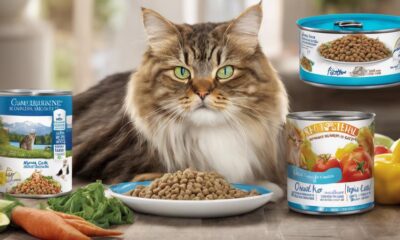
 Vetted2 months ago
Vetted2 months ago15 Best Wet Cat Foods for Older Cats to Keep Them Healthy and Happy
-

 Vetted2 months ago
Vetted2 months ago14 Best Homemade Dog Food Recipes Your Pup Will Love – Vet Approved & Nutritious
-

 Cats1 week ago
Cats1 week agoTop 5 Cat Breeders in Arkansas: A Guide





















